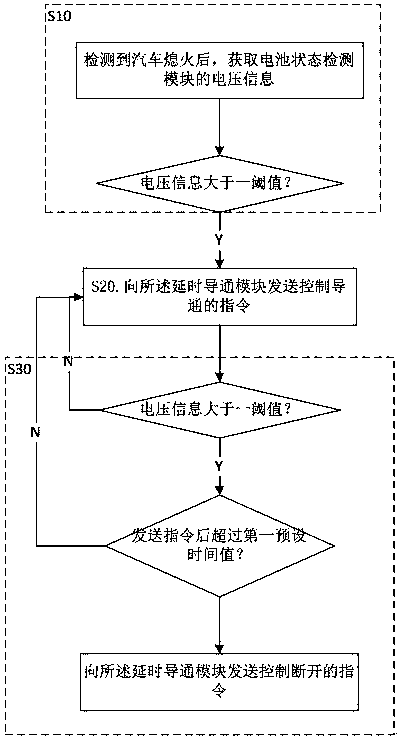Odor preventing method and system for vehicle-mounted air conditioner
A vehicle air conditioner and anti-odor technology, which is applied in vehicle parts, air handling equipment, heating/cooling equipment, etc., can solve the problems of unpredictable time for parking and flameout, driver inconvenience, and small scope of application, to prevent battery loss. point, to ensure the effect of energy saving and purification
- Summary
- Abstract
- Description
- Claims
- Application Information
AI Technical Summary
Problems solved by technology
Method used
Image
Examples
Embodiment 1
[0035] An anti-odor system for a vehicle air conditioner is used to adjust the temperature of the refrigeration components of the vehicle air conditioner after the vehicle is turned off, so as to prevent it from mildew and odor due to low-temperature condensed water droplets. Such as figure 1 As shown, it specifically includes: a delay conduction module, a vehicle status detection module and a battery status detection module.
[0036] The delay conduction module is connected between the blower and the car battery power supply. Since the delay blower is directly connected to the car power supply through the delay conduction module, it is a constant power supply. Therefore, when the delay conduction module is turned on, the blower supplies power. Not affected by the ignition status of the car. The input terminal of the whole vehicle status detection module is connected to the signal output terminal of each component of the vehicle, which can be acquired by CAN bus, LIN bus or h...
Embodiment 2
[0041] On the basis of Embodiment 1, this embodiment provides a method for preventing peculiar smell of a vehicle-mounted air conditioner, such as image 3 shown.
[0042] An anti-odor method for a vehicle-mounted air conditioner, based on a delay conduction module, a battery state detection module, and a vehicle state detection module, comprising the following steps:
[0043] S10. After detecting that the vehicle is turned off, obtain the voltage information of the battery state detection module, and if the voltage information is greater than the first threshold, perform step S20.
[0044] Specifically, in the case of parking with the engine turned off, the battery status is judged to ensure that the voltage of the cycling battery is sufficient to support the operation of the blower without power loss.
[0045] When it is detected that the power supply voltage is lower than the first threshold when the engine is turned off and parked, the blower with this function is not all...
Embodiment 3
[0050] The difference between this embodiment and Embodiment 2 is that step S10 is optimized in this embodiment.
[0051] In order to avoid the false triggering problem caused by the driver shutting down the vehicle briefly, and also considering the time required for the occupants to get off the vehicle, a large amount of wind will cause discomfort to the user. Also include a delay step before obtaining the car battery voltage in step S10:
[0052] S101. Detect the engine-off state of the car, and start to delay timing if the engine is turned off;
[0053] S102. Continue to execute step S10 after the delay timing is completed.
[0054] The delay time can be between 1 minute and 3 minutes.
PUM
 Login to View More
Login to View More Abstract
Description
Claims
Application Information
 Login to View More
Login to View More - R&D
- Intellectual Property
- Life Sciences
- Materials
- Tech Scout
- Unparalleled Data Quality
- Higher Quality Content
- 60% Fewer Hallucinations
Browse by: Latest US Patents, China's latest patents, Technical Efficacy Thesaurus, Application Domain, Technology Topic, Popular Technical Reports.
© 2025 PatSnap. All rights reserved.Legal|Privacy policy|Modern Slavery Act Transparency Statement|Sitemap|About US| Contact US: help@patsnap.com



